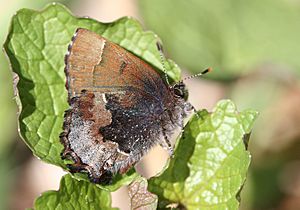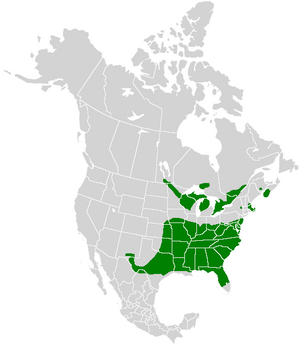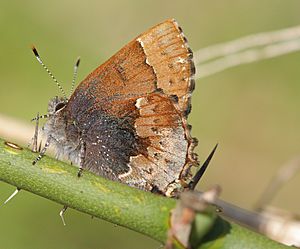Henry's elfin facts for kids
Quick facts for kids Henry's elfin |
|
|---|---|
 |
|
| Conservation status | |
| Scientific classification | |
| Kingdom: | |
| Phylum: | |
| Class: | |
| Order: | |
| Family: | |
| Genus: |
Callophrys
|
| Species: |
C. henrici
|
| Binomial name | |
| Callophrys henrici (Grote & Robinson, 1819)
|
|
 |
|
| Synonyms | |
|
|
The Callophrys henrici, also known as the Henry's elfin or woodland elfin, is a small butterfly found in North America. It belongs to the butterfly family called Lycaenidae.
In Canada, you can find this butterfly from southern Manitoba to southern Nova Scotia. In the United States, it lives in two main areas. One group lives along the Atlantic Coast and eats different types of holly plants. The other group is mostly found in the northern parts of the US and the Appalachian Mountains. These butterflies eat redbud trees.
The Henry's elfin butterfly is becoming more common in New England. This is because it has started using an introduced plant called buckthorn as a food source. In the US state of Connecticut, it is listed as a species that needs special attention.
Contents
What Does It Look Like?
The top side of this butterfly's wings is a dark brown color. The underside of its wings has two strong colors. The part closest to its body is dark brown or black.
The hindwing (back wing) has a white line near its outer edge. The very edge of the hindwing looks frosted, and sometimes the outer edge of the forewing (front wing) has a green tint. Its hindwings have short, stubby tails. In the southeastern US, these tails are a bit longer.
Male Henry's elfins do not have a special scent patch called a stigma. This butterfly's wingspan is about 20 to 25 millimeters (0.8 to 1.0 inches) wide.
Butterflies That Look Similar
Several other butterflies look a lot like the Henry's elfin. These include the frosted elfin, the brown elfin, and the hoary elfin.
The frosted elfin is a little bigger. Its males have a stigma, and the underside of its hindwing has more frosting. It usually has a dark spot near the outer edge of its hindwing.
The brown elfin is more reddish-brown. Its males also have a stigma, and it does not have tails on its hindwings. The underside of its hindwing does not have any frosting.
The hoary elfin is smaller than the Henry's elfin. Its males have a stigma, and it also lacks hindwing tails. The entire outer edge of its hindwing is frosted on the underside. Its forewing outer edge is also frosted.
Where Does It Live?
Henry's elfin butterflies can be found in many different places. They live in open, rocky areas called barrens. They also like coastal forests with holly trees, open woodlands, and mesquite woodlands.
When Does It Fly?
You can see this butterfly flying at different times depending on where it lives. In the northern areas, it flies from early May to early June. In the southern areas, it flies earlier, from March to April.
Life Cycle
Male Henry's elfins often wait for females at about eye level. Sometimes they perch high in trees or very low to the ground. Females lay their eggs one by one. They place them on the flower buds of their host plants or on leaves near the buds.
The eggs are pale green at first. They turn whitish just before they hatch. The larva, or caterpillar, can look very different from one to another. They can be greenish-yellow, red-brown, or maroon. They have spots on their sides that can be white, yellow, green, or red-green. They also have a stripe along their side that can be yellow or reddish. Some caterpillars have a faint yellow or reddish stripe down their back.
The pupa (the stage before becoming an adult butterfly) is orange-brown. It has dark brown-black spots. The pupa spends the winter (hibernates) hidden in fallen leaves. Henry's elfin butterflies have one group of babies (brood) each year.
Host Plants
The caterpillars of the Henry's elfin butterfly eat the leaves of several different plants:
- Redbud, Cercis canadensis
- Dahoon holly, Ilex cassine
- American holly, Ilex opaca
- Yaupon holly, Ilex vomitoria
- Black buckthorn, Rhamnus frangula
- Mexican buckeye Ungnadia speciosa
- Vaccinium species (like blueberries and cranberries)
- Viburnum species, including Maple-leaf viburnum, Viburnum acerifolium



